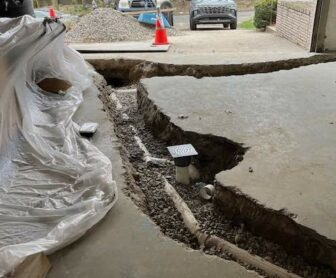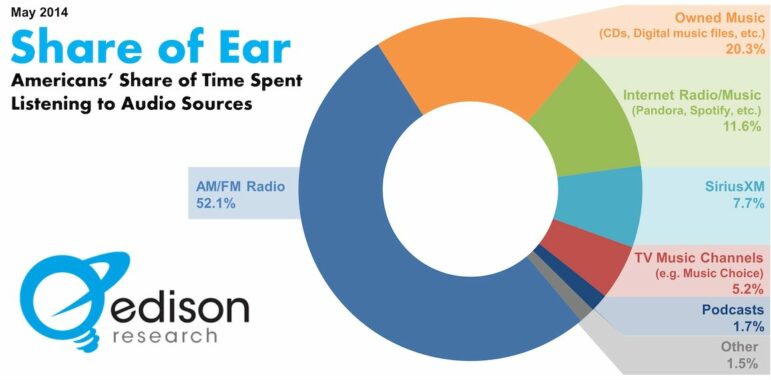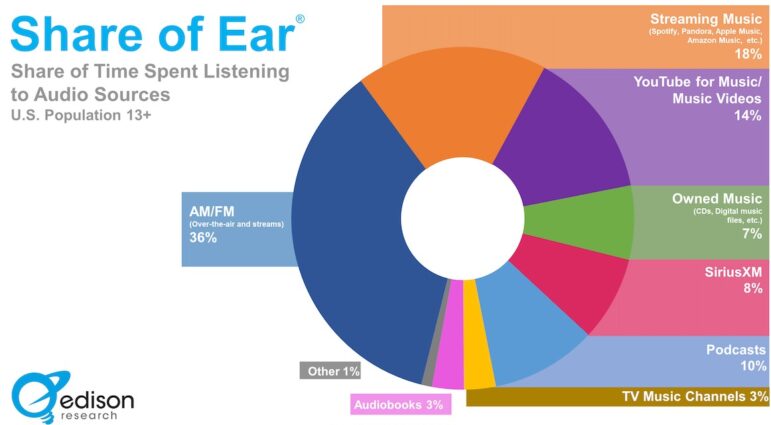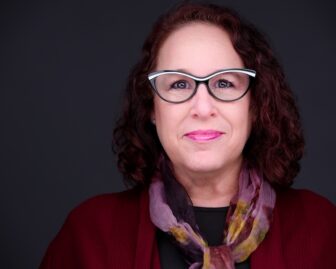It’s time for public radio to fix problems in its foundation

Mike Janssen, using DALL-E 3
We own a 60-year-old house, which isn’t terribly old by most standards. It was built with quality materials and went through a couple of updates before my husband and I bought it back in 2012.
It’s a beautiful home but needs maintenance. While talking to a friend about our most recent renovation project, it struck me how much this project is a metaphor for the reconstruction needed in public media right now. Let me explain.
About seven years ago, we noticed a problem with our wastewater system. Sludgy water backed up through a drain of the utility room. A plumber made a temporary fix but told us there was a much larger issue that we should have checked out. We went on with our lives.
The problem reappeared periodically, but we always managed to patch it up and move on. Two years ago, we couldn’t put it off any longer. A top-rated plumber diagnosed the problem, which turned out to be extensive. Cast-iron wastewater pipes running under the concrete slab below the utility room, laundry room, downstairs bathroom, entryway and garage had to be replaced. The job would require multiple experts to remediate the plumbing and restore these areas of our house to normal use.
There were to be no more quick fixes. We needed a permanent solution.

Still, it took months of research and meetings with contractors — and then we had to wait until spring to start the job. We used the time to clean out rooms where the floors were about to be jackhammered and created a staging area in the garage for contractors and their equipment. We laid the groundwork for our project to run smoothly from start to finish.
When the plumbers finally began the job, they replaced the entire wastewater system – 80 feet of pipe. We saw more of the guts of our house than we ever wanted or needed to. The experience made me think about the problems that public radio is facing.
Radio’s declining ‘Share of Ear’
Our system is built on “listener-sensitive” revenue. The two largest sources of funding are membership and underwriting, both of which rely heavily on broadcast performance. For example, when fundraisers look at the effectiveness of their membership program, they compare their net revenue to the size of their broadcast audience.

As we know from Edison Research’s Share of Ear study, radio consumption is leaking in a way that damages public radio’s stability. Just 10 years ago, Americans spent more than half of their audio time listening to AM/FM radio. YouTube Music wasn’t a thing back then. Podcasts had barely penetrated the market.
Fast forward to 2023 and it’s not hard to see how much the media landscape has shifted. Nearly every other channel has seen steady growth as accessibility and ease of use improve with technology. Meanwhile AM/FM radio, including its digital streams, have continued to lose ground. Losses to public radio’s “share of ear” have eroded our financial model to the point that it’s in need of structural repair.

New technologies have captured the attention of our audiences and the competition has never been more fierce in the audio space. The Share of Ear study shows plainly how radio consumption has declined in the last decade. Public radio is not immune to this situation. The pandemic may have permanently altered how people consume media and yet our revenue structure is still built on a broadcast foundation.
The public radio sector is filled with incredibly smart and creative people with amazing ideas. We’ve known about these challenges for a long time. But, like with the overdue plumbing project in my house, we’ve put off taking action and doing the full diagnostic workup to find the best solution.
People get ready
Instead of “ready, aim, fire,” the sector tends to employ a “ready, fire, aim” approach to attacking problems. That means committing resources before establishing a shared understanding of how to support the necessary work long-term.
For our plumbing project, my husband and I spent two years getting ready and four months aiming before we were able to pull the trigger. While the delay didn’t impact us financially, there could have been a catastrophic failure at any moment, which would have caused a lot more damage to our home. Public radio doesn’t have the luxury of time. We must act with a greater sense of urgency.
We can’t change decisions from the past that brought public radio to this point, but we can act in ways that will affect its future. We need a lot of information to help us make the best decisions. It will take time to collect and disseminate that information. Patience is not an easy thing to acquire, but it’s necessary if you want to hit your mark.
It seems clear that digital audiences don’t have the same relationships with our brands as traditional radio listeners. I believe it’s unwise to apply findings from studies like Audience 98 to today’s audiences. Our industry needs research that gives us a shared understanding of digital audiences and the media they consume and support financially. It’s time to get “ready” by doing the research that will help us prepare for the substantial improvement project that’s ahead.
This is why PMCC is partnering with our colleagues at Station Research Group, Greater Public and City Square Associates on the next phase of national research — Researching Unmet Needs 2024, which we’re calling RUN. This follows the 2023 Public Radio Meta-Analysis report that looked at the perspectives of potential audiences from across the country. A playbook drawn from that analysis offered strategic guidance for public media stations to transform themselves from passive broadcasters who deliver national radio shows into essential community assets who play active roles in the civic life of their communities.
Now getting underway, RUN 2024 is designed to identify the unmet needs of music and news and consumers in all 50 states and look for opportunities where public media is uniquely positioned to meet those needs. Our study includes local market modules that will give public broadcasters important data and insights into their own service areas. You can learn more about RUN 2024 here.
While we’re talking about research, pay attention to the Public Radio Techsurvey, a partnership with Jacobs Media. It’s one of the most important diagnostic tools we have to understand our core radio audience. With 15 years of findings, PRTS tracks the habits, behaviors and attitudes of public radio’s biggest fans. The people who take this survey are in your email database, follow your stations on social media, choose your station first, sign up for events and wear your swag to the grocery store. To me, PRTS performs the same service as the plumber who first snaked our wastewater drain and told us we had a potential disaster under the house. PRTS 2024 will be in the field this summer, and you can find out more here.
Just like with the plumbing in our house, public radio can’t wait any longer to take action on the leaks in its foundation. They aren’t going to disappear. In fact, more critical systems will fail if we allow the problems to fester.
Now that the plumbing repair in our house is complete and the renovation of the affected rooms is underway, we know that this critical system is in the best possible working condition. We don’t have to worry about drains backing up — and neither will the next owners of this beautiful home. The extensive upgrade to the plumbing system has improved the comfort and value of our house for decades to come. The foundation is strong.
I see many strengths in public radio’s foundation, despite the repairs that need to be done. Many Americans recognize the important role public media plays in our society. Our news coverage nationally and locally helps keep our democracy strong. Our national and local brands are beloved by millions. As nonprofit media organizations with mission as our focus, we are committed to public service that improves local communities. This is a strong foundation on which to build.

We are stewards of this national treasure. Now let’s roll up our sleeves and get to work.
Abby Goldstein is president and executive director of Public Media Content Collective, a membership organization that helps content leaders and managers understand, serve and grow audiences. Her experience in public radio programming and management includes working at KERA in Dallas and New Hampshire Public Radio. She also led WYEP in Pittsburgh to unprecedented audience and revenue growth as GM. From 2008 to 2016, she served on the board of the Public Radio Program Directors Association, the original brand identity of PMCC.






This is helpful Abby. I applaud the RUN concept and its high potential to help guide public radio in its future direction! I am excited to see results from an unbiased look at what these potential audiences will tell us. I am quite confident we will hear some uncomfortable truths that need to be addressed head-on. I encourage us to not “explain them away” or to get defensive about the results, based on what we “think potential audiences need” vs what they actually tell us they want. Let’s leave our collective baggage at the door of the presentation room as we enter to hear the results of this important work. Thank you for setting the table for us.
Both Public radio and PBS play the same mundane commercials for funding for months even years. It become noxious and display an insensitivity to listener no wonder they leave. I going to YouTube and scratching both from my will. I’m tired of being hustled for it with the same pitch.
Hugh